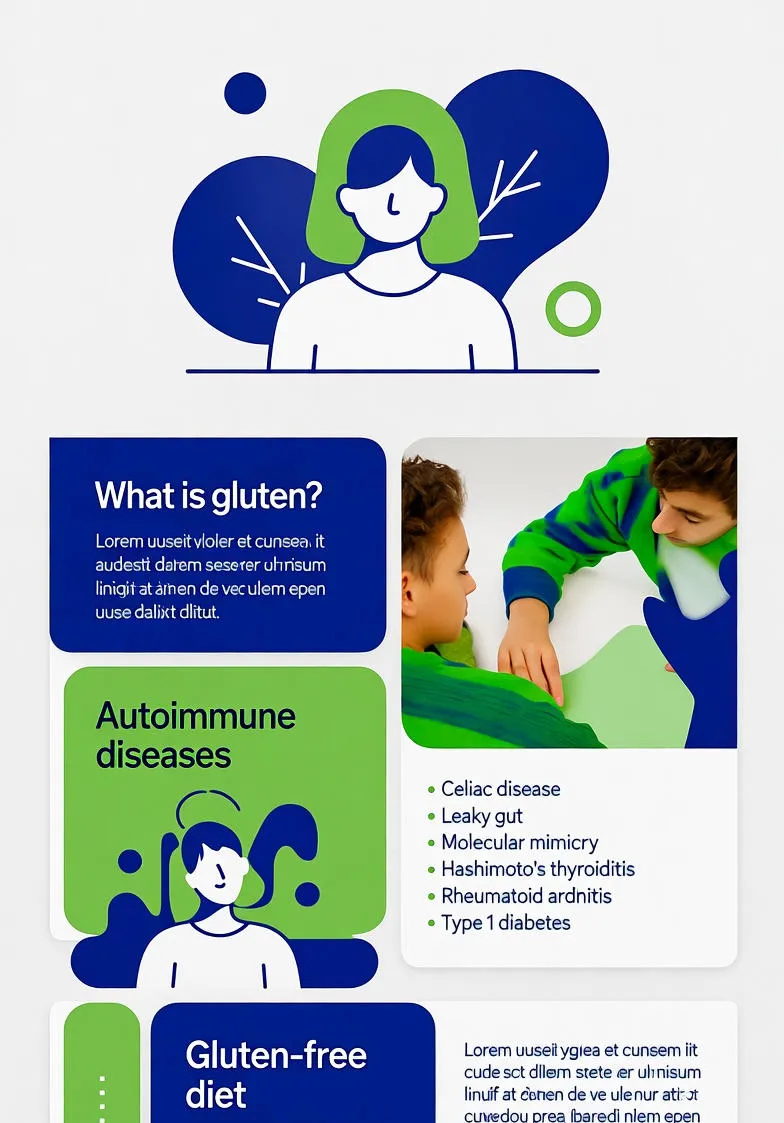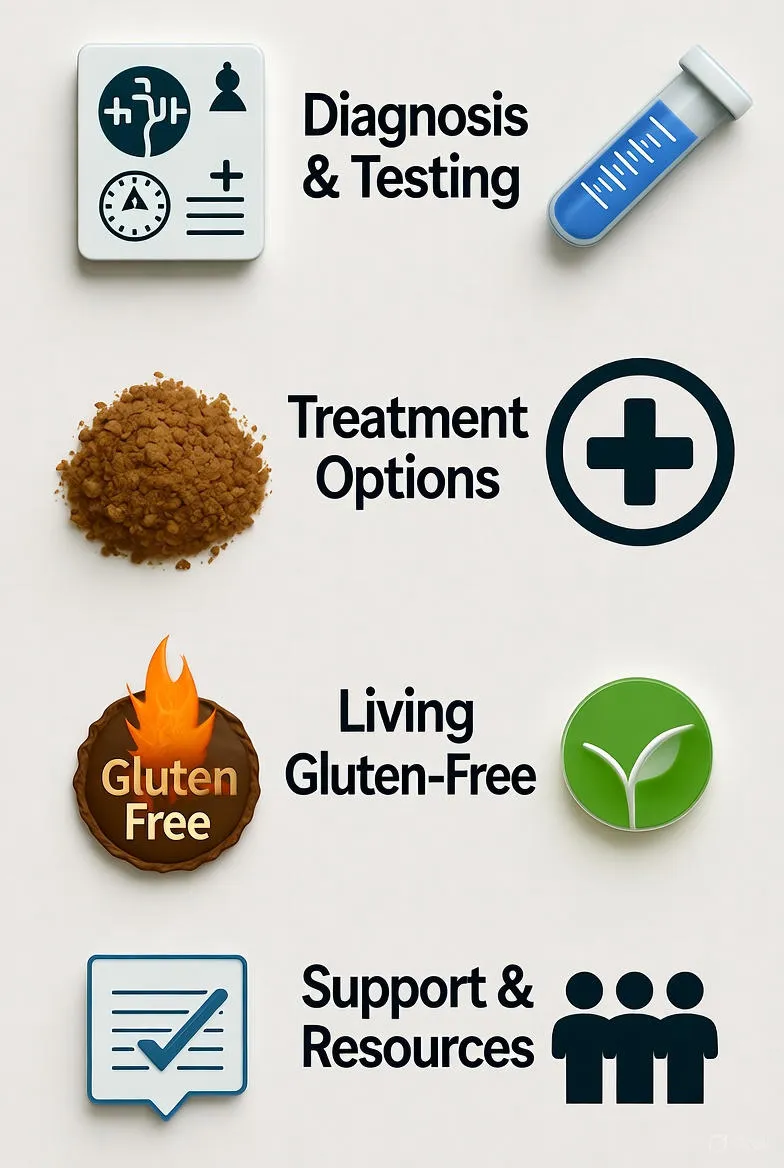The Hidden Trigger: How Gluten Fuels Autoimmune Diseases
Discover how gluten contributes to autoimmune diseases through leaky gut and molecular mimicry. Explore linked conditions like celiac, Hashimoto's, and RA, plus evidence-based benefits of a gluten-free diet for better health.

Introduction
In the intricate dance of the human immune system, gluten—a protein found in wheat, barley, and rye—plays an unexpectedly disruptive role. For many, gluten is simply a staple in bread and pasta, but for those predisposed to autoimmune conditions, it can act as a silent saboteur. Autoimmune diseases, where the body mistakenly attacks its own tissues, affect millions worldwide. Conditions like celiac disease, rheumatoid arthritis, and Hashimoto's thyroiditis share a common thread: inflammation triggered by dietary factors, with gluten often at the center. This article delves into the mechanisms by which gluten contributes to these disorders, exploring scientific insights and practical strategies for management.
What is Gluten?
Gluten is a composite of storage proteins called prolamins and glutelins, making up about 80% of the protein content in wheat. Its elasticity gives dough its stretchy quality, essential for baking. However, this same resilience makes it resistant to complete digestion in the human gut. Gliadin, a key component of gluten, is particularly notorious for its potential to provoke immune responses. In susceptible individuals, undigested gliadin fragments can interact with the intestinal lining, setting off a cascade of inflammatory events.
While gluten has been a dietary mainstay for centuries, modern processing and high-gluten wheat varieties may exacerbate its effects. Cross-contamination in food production further complicates avoidance for those who need it. Understanding gluten's structure is crucial to grasping why it poses such a challenge to the immune system.
Understanding Autoimmune Diseases
Autoimmune diseases arise when the immune system, designed to protect against invaders, turns inward. Over 80 such conditions exist, ranging from localized issues like psoriasis to systemic ones like lupus. They disproportionately affect women and often cluster in families, suggesting genetic vulnerabilities interplaying with environmental triggers.
The hallmark of autoimmunity is the production of autoantibodies—proteins that target self-tissues. This misguided attack leads to chronic inflammation, tissue damage, and organ dysfunction. Factors like infections, stress, and diet can tip the balance toward autoimmunity. Among these, gluten emerges as a dietary culprit, particularly in genetically susceptible populations carrying HLA-DQ2 or HLA-DQ8 genes.
The Gut Connection: Leaky Gut Syndrome
At the forefront of gluten's impact is its role in compromising gut integrity, a phenomenon known as leaky gut or increased intestinal permeability. The gut barrier, maintained by tight junctions between epithelial cells, prevents harmful substances from entering the bloodstream. Gluten disrupts this barrier by upregulating zonulin, a protein that loosens these junctions.
Research shows that in celiac disease, gliadin binds to the CXCR3 receptor on intestinal cells, triggering zonulin release. This allows undigested food particles, bacteria, and toxins to leak through, alerting the immune system. The result? Systemic inflammation and sensitization to self-antigens, paving the way for autoimmunity.
Studies link leaky gut not only to celiac but also to other conditions like type 1 diabetes and multiple sclerosis. For instance, elevated zonulin levels correlate with disease activity in these patients. Healing the gut—through diet and probiotics—can mitigate these effects, underscoring the gut's role as the gateway to immune health.
Molecular Mimicry: Gluten's Deceptive Similarity
Another insidious mechanism is molecular mimicry, where gluten peptides structurally resemble human proteins, fooling the immune system into attacking the body's own tissues. Gliadin shares sequence homology with components of the thyroid, pancreas, and joint linings, explaining its links to diverse autoimmunities.
In Hashimoto's thyroiditis, for example, antibodies against gliadin cross-react with thyroid peroxidase, an enzyme essential for hormone production. Similarly, in rheumatoid arthritis, gluten mimics synovial proteins, exacerbating joint inflammation. This mimicry is amplified by tissue transglutaminase (tTG), an enzyme that deamidates gluten, enhancing its immunogenicity.
Scientific literature, including studies on non-celiac gluten sensitivity, supports this. Patients exhibit elevated anti-gliadin antibodies that correlate with autoantibody levels, suggesting a direct causal link. Breaking this cycle requires eliminating the mimicking antigen—gluten—from the diet.
Specific Autoimmune Conditions Linked to Gluten
Celiac Disease
As the quintessential gluten-related autoimmune disorder, celiac disease affects about 1% of the population. Ingestion of gluten triggers an immune attack on the small intestine, leading to villous atrophy and nutrient malabsorption. Untreated, it heightens risk for other autoimmunities, with up to 17% of patients developing additional conditions.
Hashimoto's Thyroiditis
The most common autoimmune thyroid disorder, Hashimoto's involves destruction of thyroid tissue. Gluten sensitivity is prevalent here, with studies showing 20-30% of patients benefiting from a gluten-free diet (GFD). Molecular mimicry between gliadin and thyroid antigens drives this association.
Type 1 Diabetes
In this pancreatic beta-cell destroyer, early gluten exposure in infancy correlates with higher incidence. A Finnish study found that delayed gluten introduction reduced risk by 50%. Leaky gut allows gliadin to sensitize the immune system against insulin-producing cells.
Rheumatoid Arthritis
Joint inflammation in RA may worsen with gluten due to increased proinflammatory cytokines like IL-15 and TNF-α. Clinical trials report symptom relief in 65% of RA patients on GFD, highlighting gluten's exacerbating role.
Multiple Sclerosis and Gluten Ataxia
Neurological autoimmunities like MS involve myelin sheath damage. Gluten ataxia, a rarer form, features cerebellar IgA deposits against tTG6. Both respond to GFD, with MRI improvements noted in responsive cases.
- Dermatitis Herpetiformis: Skin manifestation of celiac, with itchy blisters resolving on GFD.
- Psoriasis: Scalp and skin plaques linked to gut permeability.
- Inflammatory Bowel Disease: Crohn's and ulcerative colitis flare with gluten in sensitive individuals.
Scientific Evidence and Studies
Decades of research illuminate gluten's proinflammatory nature. A 2023 review in the Journal of Translational Gastroenterology posits gluten as a key inducer of autoimmunity via NFκB activation, inflammasome triggering, and microbiome dysbiosis. Ex-vivo studies demonstrate gliadin's pro-apoptotic effects on enterocytes.
Epidemiological data from the Celiac Disease Foundation reveals a 10-fold increased risk of autoimmune thyroid disease in celiac patients. A PMC study on 64 celiac adults found 17% comorbidity rate, with hypothyroidism predominant. Logistic analyses suggest prolonged gluten exposure modifies immune tolerance.
Intervention trials bolster GFD efficacy. In non-celiac autoimmunities, 70-80% report reduced fatigue and pain. Microbiome shifts toward anti-inflammatory short-chain fatty acid producers further support gut healing. However, challenges persist: not all respond, and nutritional deficiencies must be monitored.
Emerging epigenetics research indicates gluten alters gene methylation, perpetuating inflammatory loops. Oxidative stress from gluten reduces glutathione, amplifying damage. These findings advocate screening for gluten sensitivity in autoimmune cohorts.
Managing Gluten Sensitivity: Diagnosis and Treatment
Diagnosis begins with serology: anti-tTG IgA, endomysial antibodies, and total IgA levels. Genetic testing for HLA-DQ confirms predisposition. Endoscopy with biopsy remains gold standard for celiac.
For non-celiac cases, elimination diets and symptom tracking guide management. Food sensitivity panels, though controversial, offer clues. Treatment hinges on strict GFD, often lifelong for celiac. Nutritional counseling prevents deficiencies in B vitamins, iron, and calcium.
Adjunct therapies include probiotics for microbiome restoration and enzymes like DPP-IV to aid gluten breakdown. Stress reduction and exercise complement dietary changes, fostering holistic remission.
Adopting a Gluten-Free Lifestyle
Transitioning to GFD demands label vigilance—gluten hides in sauces, soups, and medications. Whole foods like rice, quinoa, fruits, and vegetables form the foundation. Certified gluten-free products ease compliance.
Challenges include social dining and cross-contamination. Support groups and apps like Find Me Gluten Free empower navigation. Long-term adherence yields benefits: improved energy, reduced flares, and better quality of life.
Beyond avoidance, an anti-inflammatory diet—rich in omega-3s, antioxidants, and fiber—amplifies gains. Personalized nutrition, guided by professionals, optimizes outcomes.
Conclusion
Gluten's role in autoimmune diseases transcends celiac, weaving through leaky gut, molecular mimicry, and chronic inflammation. While not a universal villain, its elimination offers profound relief for many. Empower yourself with knowledge: test, treat, and thrive. Consult healthcare providers to tailor approaches, reclaiming health one gluten-free bite at a time.
(Word count: 1,248)


